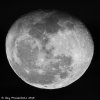I am taking the first shots with my new 100-400 II and decided to try it out on last night's full moon (1/6/2015).
I used my 7D +100-400 II mounted on a sturdy tripod. I shot against the dark sky at 400mm to get maximum image size (FF equivalent 640 mm).
Since moonlight is reflected sunlight, a typical daytime exposure ought to work fine. I shot in manual mode using 1/100 sec at f/11 and ISO 200. This exposure seemed OK, but maybe not optimum?
My trouble was in getting the focus right to get images with the sharpest possible detail.
I used manual focus in live view magnified 10x. I took each shot using the camera 10-sec self-timer and cable release to minimize camera shake.
I was disappointed in the lack of detail of my images. But maybe I had unrealistic expectations and have done about as good as can be expected within the limitations of my equipment - definitely no telescope available.
Still the attached uncropped image shows craters at 10 o'clock that I definitely cannot see from the ground!! So this is an improvement over my own eyesight!!
I'm looking for feedback from others who have taken shots of the moon using equipment similar to mine. Did you get better images than my attached sample. If so, what were your procedures?
Any feedback welcome and appreciated.
Thanks!
I used my 7D +100-400 II mounted on a sturdy tripod. I shot against the dark sky at 400mm to get maximum image size (FF equivalent 640 mm).
Since moonlight is reflected sunlight, a typical daytime exposure ought to work fine. I shot in manual mode using 1/100 sec at f/11 and ISO 200. This exposure seemed OK, but maybe not optimum?
My trouble was in getting the focus right to get images with the sharpest possible detail.
I used manual focus in live view magnified 10x. I took each shot using the camera 10-sec self-timer and cable release to minimize camera shake.
I was disappointed in the lack of detail of my images. But maybe I had unrealistic expectations and have done about as good as can be expected within the limitations of my equipment - definitely no telescope available.
Still the attached uncropped image shows craters at 10 o'clock that I definitely cannot see from the ground!! So this is an improvement over my own eyesight!!
I'm looking for feedback from others who have taken shots of the moon using equipment similar to mine. Did you get better images than my attached sample. If so, what were your procedures?
Any feedback welcome and appreciated.
Thanks!






